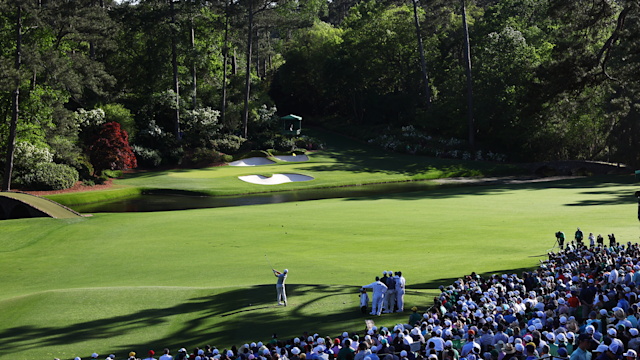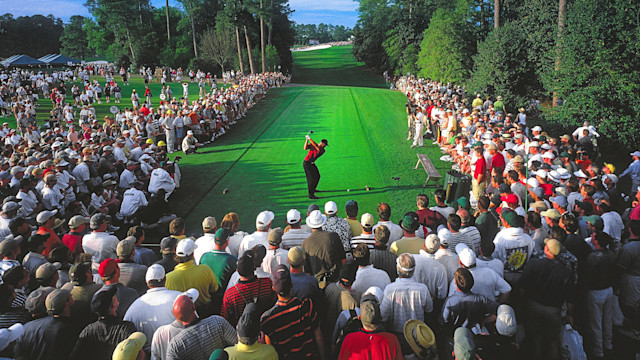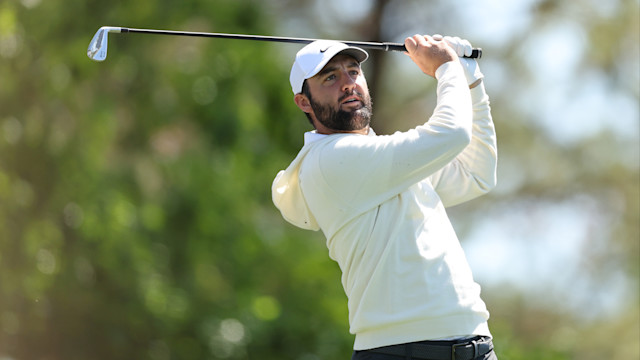Course Spotlight
How to Play the 13th Hole at Augusta National
By Tony Starks
Published on

The 13th fairway and green at Augusta National Golf Club. (David Cannon/Getty Images)
Augusta National may be the most familiar piece of land in all of golf. We know this place. Every slope. Every green. Every blooming azalea and towering pine.
And yet, for all its visibility, Augusta remains one of the most exclusive experiences in the game. To walk its fairways, to put a peg in the ground beneath those Georgia pines, is a privilege few ever realize.
In honor of the 89th playing of the Masters, we turned to four PGA of America Golf Professionals who’ve done just that – played Augusta. What follows is their perspective on how to approach the legendary par-5 13th, a hole that has shaped champions and delivered historic moments.
Living in Georgia and working at Atlanta Country Club, I’ve been lucky to play Augusta National a handful of times over the years – thanks to two of our members who also belong there. The memories of playing the course are clear as day. Especially 13.
To me, the key is deciding what kind of player you want to be off the tee. From the back box, if you’re a bomber, you pick a line and commit. You either try to sling something around the corner or play it safer out to the right and lay up. Either way, it starts with your decision on the tee.

The 13th tee shot (seen in the distance) requires some thought.
I’ve played it from both the members and championship tees, and honestly, each presents its own challenges. From up front, it’s almost trickier. You’ve got to hit 3-wood or hook it pretty hard to get a good look in. I’ve approached it both ways, but my last time out, I got lucky – hit a rope draw around the bend and had just 171 in.
But that second shot? It’s no gimme. The ball sits above your feet, so naturally you think it’s going to hook. But it doesn’t hook as much as you think. You’ve got to really commit to the release if you want to turn it in there.
Then you get to the green – and that’s where things get interesting. The front-left pin looks like a green light, but guys bail out because of the creek. That leaves you with this delicate little chip through sticky rye grass. Hit it too soft, it doesn’t get there. Hit it too firm, and suddenly you’re down the slope with a 50-footer coming back.

And if the pin’s tucked back right? That one’s sneaky. From the lower level, it looks like it should break a ton, but it doesn’t. Plus, it’s slow going uphill. You see a lot of guys come up short – they’re scared to run it past, but they don’t quite hit it enough.
I still remember watching Tiger’s 2019 win… from the golf shop. My assistant actually called me during the final round from a course phone. Our caller ID said “Augusta National Golf Club,” and I’m thinking, who the hell is calling me from there right now? He gets on the line and just says, “Man, he’s gonna freaking do it. I can’t believe you’re not here.”
That might be my one regret in life.
Scott Schroeder,
PGA Director of Golf,
Atlanta (Georgia) Country Club
PGA Director of Golf,
Atlanta (Georgia) Country Club
I can’t say who the call came from, but it was one of those conversations that golfers dream about – just a casual, “What are you doing next week?” followed by, “Want to come play Augusta?” You don’t ask any questions. You just say yes.
However, my wife’s a golfer, too, and we always had a rule: if that call ever came, I could say yes on the spot as long as I asked, “Is there room for two?” Turns out this was a solo mission. I was joining a threesome, so I packed up and flew out with seven days’ notice. We played the par-3 course, then the big course and then I was back in Atlanta before I really had time to process it all.
Thirteen is such a brilliant risk-reward hole. Off the tee, for someone who plays the fade like me, you’re trying to hug that tree line on the left to avoid the creek while making sure you stay below the pines out right. I actually hit a solid drive and decided to give the green a go in two. I barely cleared the creek in front but didn’t reach the green – chipped on and just missed my birdie putt.
As soon as I finished the hole, I thought, “Man, I’d like a do-over.” I should’ve taken more club and aimed long-left. That’s the better miss.

There’s genius in how uncomfortable that second shot feels. You’re likely standing on a slight hook lie with a long iron in hand, ball above your feet, wind swirling and you’re staring down to this narrow, elevated green with a creek waiting to punish anything short. It's a decision hole. If you go for it and miss, you're likely walking away with bogey.
I also think left-handed players have a slight edge. That fade they can play shapes perfectly off the tee, hugging the right side and working back into the fairway.
You think about Sergio when he clipped the trees left, found his ball and somehow still made magic happen. That hole allows for that kind of drama.
I had two goals for the round going in: Break 80 and make a birdie. I shot in the 70s, but no birdies on the card. Honestly? I never really think about what I shot or how I played, the honor of playing Augusta National is more than enough.
Jeff Simonds,
PGA Director of Golf,
Bandon (Oregon) Dunes Golf Resort
PGA Director of Golf,
Bandon (Oregon) Dunes Golf Resort
I’ve had the honor of playing Augusta National three times, but long before I ever stepped foot on the course, it was already in my blood. My grandfather was part of President Eisenhower’s detail at Fort Gordon, just outside of Augusta. When Ike came down to play, it was my grandfather who drove him back and forth from the base to Augusta National. They became close, and after Eisenhower left office, he gave my grandfather Masters badges.
From then on, the tournament was a fixture in our family. Spring break for me wasn’t about the beach – it was about being in Augusta while the adults went to the tournament.
In 1986, we were there again. My dad had cancer, and by that Sunday he’d been admitted to the hospital. While the rest of my family went to visit him, I was given a ticket to the tournament and found myself following Jack Nicklaus from 11 through 18. I watched him shoot 30 on the back nine, coming from behind to win at 46 years old – the same age as my dad. That Tuesday, my father passed away.

That week changed my life. Jack was my dad’s favorite player. Watching him do something so extraordinary in his final Masters win – at the same age as my father – lit something in me. I came home and started playing golf.
So, yeah. When I finally teed it up at Augusta for the first time, it was more than a round. I’ve played in U.S. Amateurs, I’ve played competitive golf for years – but I was more nervous on that first tee with just three friends watching than I’ve ever been in competition.
I was fortunate to be invited by a member who brought me, another PGA Professional and an LPGA Tour player. We played the tournament tees while the other two played up. But honestly, the setup didn’t matter – it was sacred ground to me.
Few holes capture that better than 13. It’s one of the most beautiful, dangerous and deceptively strategic par fives you’ll ever see. I’m a long hitter – 300 yards is routine, but even then, I’ve only gone for the green once in three rounds. And that first time, I absolutely roasted it… dead straight. Problem is, you need a draw. The ball ended up in the pine straw – what I call the “Mickelson pines” – and I had no angle. I had to play down 14 fairway and pitch back over.

Honestly, it’s not the worst miss. The closer you get to the green from that side, the more it opens up and the slopes actually give you something to work with. It’s a little bit of a secret play . . . they even have yardage markers over there to the 13th green.
Still, it’s an incredibly intimidating shot – even with a wedge in your hand. The green is cut in half, there’s no safe miss and the ryegrass overseed in January means you’re not getting much roll. The lies are tight and hanging, and there’s always spin to manage. That’s Augusta – what looks simple becomes complex the more you play it.
What makes 13 so brilliant is how much the strategy changes based on the pin. Great players walk backward through the hole: if it’s a green light pin, you might take a more aggressive line off the tee. If it’s tucked, you might club down and lay back. That new tee they’ve added only deepens the challenge – you have to absolutely nuke it just to get around the corner and see the green.

But that’s Augusta. It’s not just the shot, it’s the setting. It’s the weight of history, the perfection of the course, the sense that every step matters. People ask me what it’s like. All I can say is, it’s a place like no other. The culture. The aura. The memories.
And for me, standing on that ground, I’m always thinking about my dad. Jack. 1986. That spring in Augusta that changed everything.
Dan Utley,
PGA Head Professional,
Owl Creek Country Club,
Louisville, Kentucky
PGA Head Professional,
Owl Creek Country Club,
Louisville, Kentucky
I’ll never forget the moment that letter showed up.
I’d coached the son of Augusta National members from fifth grade all the way through high school. We won a state championship together in Alabama, and it was the kind of season that leaves a mark on everyone. That fall, I received a letter with Augusta National letterhead. I still keep it on my desk. It read:
“The golf team under your leadership gave us all a permanent memory of excellence. This year, our time at Muscle Shoals will always be some of the best days for parents. I thank you for that. Please accept my invitation to join me at Augusta National next season. We will raise a glass to the victory and golf’s greatest venue. We’ll figure out the dates as fall approaches. Head down, my friend.”
That was the beginning of something I’ll never forget. We didn’t just play the course. We flew in the day before, had dinner at the club, stayed the night in Butler Cabin, then played 18 the next morning. After lunch, we played the back nine again. The golf was spectacular, sure, but the atmosphere – the history, the hospitality, Butler Cabin – made it unforgettable.
And then there’s 13.

Both times I played it, I found the fairway. The first time, I had a great look and went for it with a 3-wood. Ended up in the back bunker. The pin was back and I hit what I thought was a solid bunker shot only to watch it roll 40 feet to the front of the green. Everyone talks about how fast Augusta's greens are, but I’ll never forget how slow that putt was coming back uphill. I still left it 10 feet short – but thankfully made that one for par.
The second time, same good tee shot, but the slope in that fairway is no joke. The ball was six inches above my feet and I didn’t like the feel of a fairway wood from that lie, so I laid up. Hit a wedge to about 15 feet and two-putted for another par. Nothing flashy – but what stuck with me was how awkward that approach shot can be, no matter where you are. TV doesn’t do it justice.
And that green? Again, surprisingly slow from back to front. You just don’t expect that at Augusta.
Oh – and there’s a hidden restroom tucked into the trees near 13 tee. You’d never know it was there if someone didn’t tell you. Just one of those little behind-the-scenes details that make Augusta feel like a world of it’s own.
Kevin Klein,
PGA Director of Golf,
Dothan (Alabama) Country Club
PGA Director of Golf,
Dothan (Alabama) Country Club


